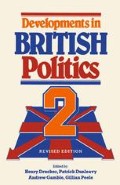Abstract
There are three main reasons why Margaret Thatcher’s Conservative government tends to be portrayed as tough. The first is the political personality of the Prime Minister. The second reason is because the main framework of reference within which British politics is conducted and analysed continues to be that of the Keynesian consensus (for example, Riddell, 1983). The third reason is that the Thatcher government’s immediate predecessors, whether Labour or Conservative, were markedly pusillanimous. So, the contrast which the Thatcher government provides seems to be a stark one. The fact of the matter is, though, that the Conservative government’s performance has not matched its radical rhetoric. After six years of Thatcher government, the radical Right was able to complain, with some justice, that ‘the Government is not proposing deep cuts in public spending’. In other words, the Prime Minister and the two men who have held the post of Chancellor of the Exchequer since 1979, Sir Geoffrey Howe and then Nigel Lawson, have continued to preach economic liberalism of market economics, as have their allies in the government and in the Tory Party.
Preview
Unable to display preview. Download preview PDF.
Editor information
Editors and Affiliations
Copyright information
© 1988 Geoffrey K. Fry
About this chapter
Cite this chapter
Fry, G.K. (1988). Inside Whitehall. In: Drucker, H., Dunleavy, P., Gamble, A., Peele, G. (eds) Developments in British Politics 2. Palgrave, London. https://doi.org/10.1007/978-1-349-10230-3_5
Download citation
DOI: https://doi.org/10.1007/978-1-349-10230-3_5
Publisher Name: Palgrave, London
Print ISBN: 978-1-349-10232-7
Online ISBN: 978-1-349-10230-3
eBook Packages: Palgrave Political & Intern. Studies CollectionPolitical Science and International Studies (R0)

